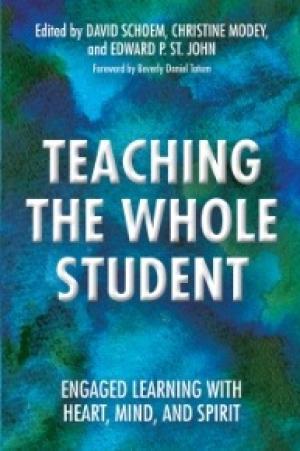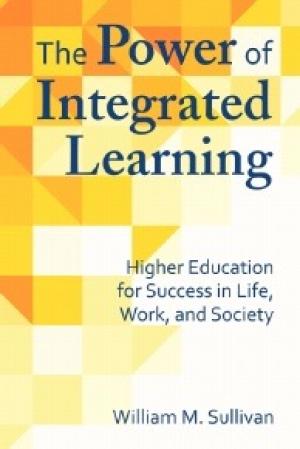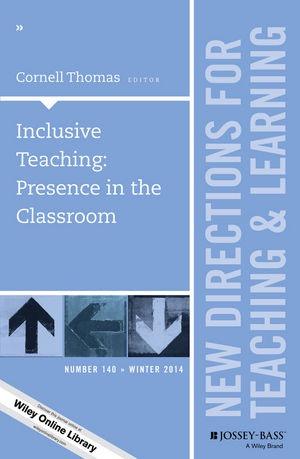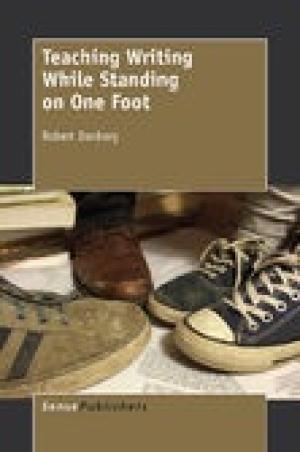Resources by C. Hannah Schell

This book gives both more and less than what its title promises. For the editors of this collection, teaching “the whole student” requires engaged learning (“active, participatory, experiential learning that links doing with thinking”) and integrative pedagogy (“crossing and stretching traditional intellectual disciplinary boundaries”) (1). In turn, these commitments are part and parcel of a larger commitment to educating for social justice, and the essays take on a wide array of topics, including effective and balanced service-learning, learning communities “done well,” and the importance of meaningful, sustained diversity engagement. Some of the essays are rather auto-biographical while others focus on a particular course or program. As is the case with many books of this type, the collection is an uneven assortment, and it is not always clear how an essay pertains to the promised subject of “teaching the whole student.” For those reasons, it can be somewhat disappointing. Read in one way, however, hope emerges as a kind of connecting line and important theme. This is addressed most directly in the essay by Gillies Malnarich, who describes a moment of personal crisis as a teacher. She lay awake at night wondering, “What does it mean to educate for hope?” How can we make space for “raw, angry, heartbreaking, life-affirming hope… especially in our classrooms,” she asks, drawing upon both Paulo Freire and Rebecca Solnit’s writings (58). It also becomes clear that the kind of relational pedagogy being prescribed by many of the writers requires a willingness on the part of the teacher to bring his or her whole self into the classroom. In her essay on “Incorporating Social Justice into Teaching,” Kathleen Manning encourages readers to think of teaching as a spiritual act: “Teaching is not something learned once and perfected. The ever-changing nature of students, theory, and your personal and professional cycles as a person and professor make teaching an art. Because you are affecting people’s lives, approaching teaching and learning as spiritual practice places it in the realm of transcendence. Particularly when using principles of social justice to work toward a more just world, faith, trust, and authenticity must be part of the teaching and learning processes” (52). There are many helpful ideas and strategies here, including the “Where I’m From” poetry assignment, a powerful way for students to disclose important aspects of their identity and express “links between their faith tradition and ethnicity,” among other things (164 - the activity comes from Beverly Daniel Tatum’s Can We Talk About Race? [Beacon, 2007]). Some of the essays include useful appendices - see, for example, the collaborative learning self-assessment (77) or the chart describing experiential classroom activities to promote dialogue (143). Ultimately the strength of this book can be found in the questions that it poses more than in the answers it suggests. Each essay concludes with a set of reflection questions prompted by the content of the essay, and a patient, thoughtful reader could work her way through this book and be richly rewarded.

Habits of the Heart (Bellah et al., U C Press, 1985) was required reading in my first-year seminar in the late 1980s. That book, and the liberal arts education into which I was being initiated, changed my life profoundly. It introduced me to new modes of thought (sociology, philosophy, religious studies), instilled a critical sensibility (concern about individualism in American culture), and planted a seed about the importance of religion within a culture (and why it is worthwhile to study it). When I saw the name of one of Habits’ authors attached to a new book on integrated learning, something my own institution takes very seriously, I was intrigued. Sullivan is a senior scholar at the New American Colleges and Universities consortium, and on one level this book merely reports on distinctive activities and programs at some of the member institutions. Those brief descriptions can be helpful and inspiring, especially if your school is embarking on similar programmatic development. A sizeable appendix offers short campus profiles of the twenty-five institutions. In the introduction, Sullivan addresses his readers as people (parents, prospective students, future faculty) who may be “looking for a college that seriously tries to integrate the liberal arts, professional studies, and civic responsibility” (1). There is a dizzying array of initiatives, but the book succeeds in its agenda of persuasion: that the ideals of integrated learning are significant and worthy. Yet, there is a second aspect to Sullivan’s agenda, and at that level the book is a lot more interesting to those already situated in higher education. Woven throughout the book, Sullivan offers insightful commentary on the significance as well as the effectiveness of integrated learning. For example, at the end of the first chapter Sullivan connects the importance of service learning with emerging research in developmental psychology. Drawing on the work of William Damon who writes about the importance of forming a sense of “life purpose,” Sullivan argues that “growing into a mature, educated person committed to significant purposes requires living in a community where values are taken seriously and structure behavior in everyday life” (27). That is precisely what our more innovative programs can do: cultivate that needed sense of purpose, which in turn fosters resilience. But in Sullivan’s hands, resilience is not just about retention and graduation rates – it is part of a larger mission to produce a healthier civic culture with an engaged, proactive citizenry. Later, Sullivan posits, “the key factor is that the members of such societies share a sense of membership in some larger whole. This gives them an ability and willingness to recognize that the well-being of each group depends on cooperation with the others. Such shared expectations and bonds are the prerequisite for a functioning, pluralistic democracy” (60). For those in theology and religious studies, this book offers a larger context in which to understand the work of instilling the virtues of tolerance and understanding. Those involved in service learning, study abroad, civic engagement, or vocation-related programming will appreciate that such initiatives are celebrated in these pages. At this level, the book can be a needed tonic for beleaguered faculty. If you share Sullivan’s ideals and his sense of the role liberal learning can play in that vision of a pluralistic, democratic society, then this book serves as a reminder of how your work contributes to that mission.

Inclusive Teaching: Presence in the Classroom (New Directions for Teaching and Learning, Number 140)
In his opening essay in the collection, editor Cornell Thomas of Texas Christian University invites readers to envision a new type of pedagogy that sees each student as a “unique being with the potential for great growth” (2). The educational philosophies of John Dewey and bell hooks grace the pages of this volume, even when they are not cited directly. The strength of this small collection lies in its variety. Ranging from an existentialism-inspired clarion call for the importance of “presence” in the classroom (Don Hufford) to a challenge posed to teachers and other mentors (in and out of the classroom) to integrate “criticality” and identity development in order to better meet the needs of students from low socioeconomic backgrounds (Anthony Walker), the essays are unfortunately a bit uneven when it comes to offering specific strategies and details about best practices. Prophetic calls for practicing “intellectual hospitality” and the value of more robust “connectedness” with our students are preaching ideas to the already converted, I suspect. Most readers of this journal likely already practice such pedagogy and are committed to creating “environments that maximize learners’ academic and social growth” (back cover). Some of the essays rely upon the briefest of anecdotes. The shining counter-example to that trend is the longer piece by Freyca Calderon Berumen and Cecilia Silva (also from Texas Christian University), describing a creative example of civic engagement for preservice teachers in an ESL class: students were matched up with newly resettled refugee families from Nepal and Burma in order to help with initial visits to local schools. The unexpected successes of their “Refugee Family Project” offers a nice example of why it is important for us to be authentic and creative if we are truly committed to more inclusive teaching. The essays offering concrete advice or descriptions of successful projects are the most rewarding, and some of the bibliographies offer further resources for anyone interested in exploring how critical race theory might be applied to our pedagogies and practices in higher education. In this vein, Kimberly Diggles’ essay is particularly helpful, as she lays out specific suggestions for implementing cross-institutional efforts that are not just racially aware but actively anti-racist in their intent and in their transformative effects on campus culture and student learning. I also appreciated Anthony Walker’s call for involving students in curricular reform as an antidote to what is otherwise “a propensity for an ideological stasis” (78). Walker goes on to state that, “a curriculum built for the integration of students’ thoughts and experiences has the ability to create a learning environment in which students are connected and engaged” (79). To the degree that teachers in religious studies have worked to develop such learning environments in their classrooms in recent years, Walker’s insights suggest that we should take the lead in larger curricular change. Unfortunately, given its brevity and the uneven quality of the essays, the collection does not ultimately deliver what is promised by the summary on the book jacket.

This book is an invitation, and is itself a somewhat circuitous reflection on teaching and learning. Directed at writing teachers, much of Danberg’s advice applies to teaching in general, and not just because faculty teach forms of writing in class. The title borrows an image from a famous rabbinic story in which Rabbi Hillel was asked by a nonbeliever to teach the whole of Torah in the time the nonbeliever could stand on one foot. “That which is hateful to you do not do to others,” Hillel instructed, “The rest is commentary; go and learn it” (13). Danberg reminds us that standing on one foot is a posture of instability, the position of both teachers and learners. He encourages teachers to remember their own difficulties in learning. Following Rosenzweig, Danberg suggests that Hillel did not mean “the rest is only commentary… To know Torah is to know the lesson, but also to participate in an ongoing conversation… into the lesson’s value” (14). Students often seek facts, principles, or methods that they can then apply, but good teachers are able to set them on a path of lifelong inquiry. A series of autobiographical vignettes in prose and poetry, the book is punctuated by reflection prompts, or “commentary.” The author employs several metaphors, but cooking images dominate. A good cook has learned not just to follow a recipe but knows how to see the possibility of a meal in the ingredients on hand; a good cook knows what a dish needs and when it is done. The implied parallel perhaps works best with the craft of writing but the larger point is about what Danberg calls “enfolded knowledge.” Teaching involves confronting the tension “between what we must tell students and what they can only know for themselves” (71). He offers a compelling description of his own learning disability – his struggles, the strategies he developed, and how teachers reacted to him along the way (47). Danberg laments that schools often define gifts narrowly and he suggests the following exercise: “Spend a couple of days observing the people around you and see how many gifts you can identify… Think of yourself as a zoologist whose great pleasure it is to wait for a butterfly they’ve never seen before” (58). Later, he describes class as “an invitation to inhabit forms of attention and attunement, patterns of caution and regard… If all goes well, it is no more mysterious than the heart and mind, that tangle we are always entangled in” (73). Danberg invokes the kabbalistic concept of tzimtzum, the contraction of the divine making space for creation. (This comes in a piece entitled “Four Principles and a Fifth” – but I counted six!). A good teacher knows when to get out of the way in order to make space for learning: “You can shape the problems and anticipate the obstacles. You can decide what a student encounters and the time it takes. But in the end, you simply must get out of the way, and leave them to do the work of learning” (98-99). Reading this book is a bit like ruminating on a Zen koan. Danberg contradicts himself and revels in paradox. The bizarre organization and genre shifts can be frustrating. This is a quirky book, but one with many moments of glittering insight into the difficult joys of learning and teaching.